New finds of multipart porcelain insulators continue to be made quite
frequently, but recently the discoveries have been astounding! Reporting of two
fantastic discoveries unfortunately will have to wait until November CJ because
I have not been able to photograph them properly for PIN. However, one super
multipart can be shown this month.
Tim Wood (NIA #1099) is always on the lookout for nice porcelain in the
Oregon area. When I get a small package of photographs from him I know he has
found a real goodie. His photographs are always outstanding, too. Tim says that
he has been blessed over the past few months by adding about 60 porcelain
insulators to his collection. He purchased a collection of nearly 1000 pieces
and had a great time unwrapping all of it. Sounds like Christmas came early this
year. We will show his best find first which was not part of the large group he
acquired. This insulator was in a lady’s front yard very near Tim’s home
along with another identical insulator with the bottom skirt broken out. The
insulator is composed of four parts cemented together (see dimensions under
photograph). I wish you could see the beautiful dark blue glaze — not the
darker cobalt blue!! The whole insulator does not have any markings. The
insulator with the broken bottom skirt has the partial Pittsburg date control
marking of “MAR 5” on the top skirt and full marking of “MAY 12 PAID” on
the bottom skirt. The color photograph of the whole insulator will probably
appear on the insulator web page (http://www.insulators.com). I have assigned
this Pittsburg insulator M-4360.
Note that the bottom skirt has a dimple in it on opposite sides similar to
M-2322 (Lapp and Locke), M-3120 (Pittsburg), and M-3164 (Lapp) all of which have
been found with a cobalt blue or dark blue glaze. This basic insulator style
(with two cutouts in the bottom skirt) is rare and has never been reported in
any color other than dark blue. Tim’s M-4360 must be quite impressive in the
dark blue color because of its large size. I suspect that these insulators were
intended to be used in a substation rather than on a pole. Three Locke M-2322’s
were found in a substation in San Antonio, TX about 15 years ago. Insulators of
this basic style (with cutouts in the bottom skirt) were probably mounted in an
underhung fashion by means of a bracket attached to the crown (note the rather
flat-top crown), and the conductor attached by laying it in the two cutouts in
the bottom skirt and secured by a tie-wire wrapped around the groove in the
bottom skirt. I’m not sure what the advantage would be for this arrangement.
The M-2322’s from San Antonio had a three-pronged bracket screwed onto a pipe
cemented in the pinhole. This arrangement was probably used to stack the
insulators to withstand high voltages.
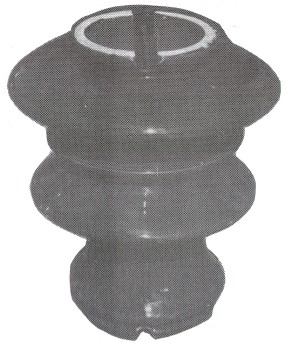
M-4360 showing crown detail. Note flat
design and raised white ring for firing rest.
M-4360
(14 - 10.5 - 12 - 8.5 - 7.5 x 16)
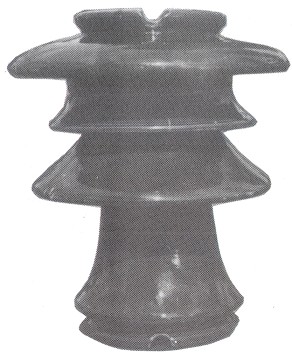
Another interesting insulator Tim reported is an unmarked M-2510 Thomas. Note
the very large chip (shown in the photograph) that was made at the factory. The
insulator in a pre-fired bisque form was probably dropped or bumped up against
something to cause the chip. The operator didn’t notice the damage and allowed
the insulator to be sent to the glazing bath. It evidently passed the electrical
test (if there was one) and made it past the visual inspection. No doubt it
served its intended purpose well. The flaw probably enhanced its appeal for the
lineman who re-moved it from the pole line and decided to take it home. This is
an interesting example of poor quality control. An insulator with a glaze-over
chip is considered to be in “mint” condition.
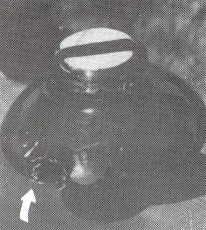
M-2510 N-N Thomas with large
glaze-over factory chip.
In my book, Value Guide for Unipart and Multipart Insulators, M-3471 was
listed as an unreported Thomas style. Bill Rohde (NIA #1219) reported an
unmarked M-3471 with the characteristic Thomas blue-jean seams inside the bottom
skirt. The glaze is a pretty mustard orange color. Jeff Kaminski (NIA #3582)
recently purchased an unmarked M-3471 which also has Thomas’ characteristic
blue-jean seam inside the bottom skirt. Jeff’s insulator is not the “ordinary”
brown color, but rather an unusual gray color! The gray color and blue-jean seam
in combination indicates that Jeff's insulator was probably made between
1905-1910. The top skirt is the typical early gray; however, the bottom two
skirts are a darker charcoal gray which adds to the unusual nature of this
insulator.
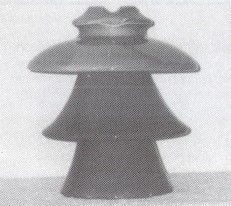
M-3471 with gray glaze and Thomas’
characteristic blue-jean seam inside
bottom skirt.
The Long Beach National was a great show. I picked up a few nice porcelain
insulators which were much too large to carry on the airplane flight back home.
It is so nice to have great insulator friends like Jim Bates (NIA #3287) who was
willing to transport a big gray M-4321 at least as far as Austin (now if I could
just convince my wife to make a trip to Austin), and Bill Rohde who eagerly
volunteered to ship a couple of big boxes plus the glass display case I won in
the dealer’s raffle (made by Rich Dawson). It is friends like this that make
our hobby the greatest. Thanks guys.
One unusual find at the National was two M-3490’s sitting on Rob Lloyd’s
(NIA #3414) table. Near the end of the show Ben Kirsten discovered something
unusual about them. He (like the rest of us) saw the insulators and naturally
assumed them to be Pittsburg items because the skirts were thick and the glaze
was rather dark. Ben needed a Pittsburg M-3490 so he bought one and later
discovered that it had Thomas’ characteristic blue-jean seam inside the bottom
skirt. Jeff Kaminski quickly caught wind of the news and snatched up the other
insulator on Rob’s table. This is a nice find for a multipart collector
because Thomas is an unlisted manufacturer for M-3490.
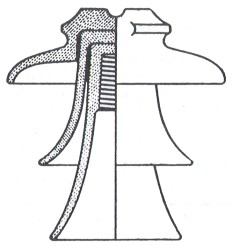
M-3490


































































